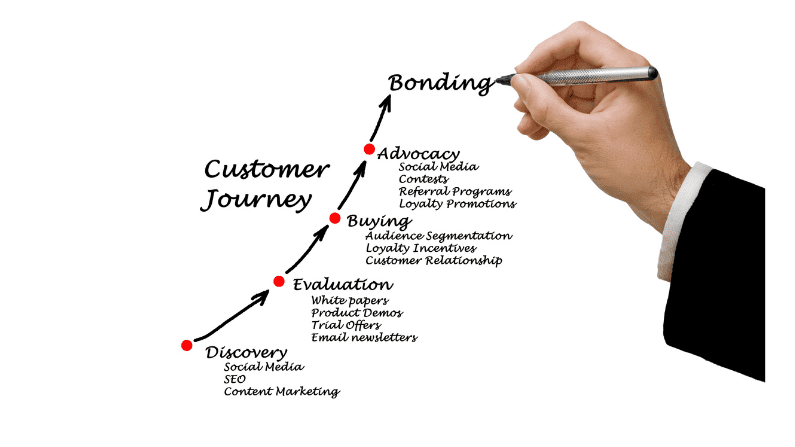Marketeering Blog
Mapping Out The Customer Journey
TABLE OF CONTENTS
What is a Customer Journey Map?
The Customer Journey Map and the Marketing Funnel
What Are the Steps in Creating Customer Journey Maps?
Mapping Out the Customer Journey
Customer Journey Mapping Examples
The Customer Journey Map is Like a 3-Act Play
Buyer Personas and the Customer Journey Map
Customer Journey Map Templates Examples
Buyer’s Journey vs. Customer Journey
Understanding Customer Touchpoints
TABLE OF CONTENTS
What is a Customer Journey Map?
The Customer Journey Map and the Marketing Funnel
What Are the Steps in Creating Customer Journey Maps?
Mapping Out the Customer Journey
Customer Journey Mapping Examples
The Customer Journey Map is Like a 3-Act Play
Buyer Personas and the Customer Journey Map
Customer Journey Map Templates Examples
Buyer’s Journey vs. Customer Journey
Understanding Customer Touchpoints

Understanding your ideal customer is crucial when creating your marketing plan. It’s not enough to know who your customers are and what they want – you also need to look at the entire experience they have with your business
This is known as the customer journey: from the first impression, right through to post-purchase satisfaction, it’s important to make sure that every step in between is as smooth and pleasing as possible for them.
This is where mapping out the customer journey comes into play. By getting a detailed overview of each stage of a customer’s experience, you can identify any areas that could be improved and understand how changes may affect them.
What is a Customer Journey Map?
A customer journey map, also known as a user journey map, is a visual story of your customer’s interactions with your brand. It’s a blend of art and science, using both data and storytelling to illustrate how a customer interacts with your business across multiple touchpoints. In essence, it’s a compelling storyboard of the customer’s experiences, filled with plot twists, climaxes, and hopefully, fairy-tale endings; that being conversions and loyalty.
This nifty diagram plays the dual role of a roadmap and a microscope. As a roadmap, it guides your customer journey strategy by aligning business activities with customer needs at each stage of the journey. As a microscope, it zeroes in on the intricacies of customer interactions, shedding light on facets that might otherwise go unnoticed.
Knowing what your customer’s needs are and the route they take to buy a product or service is what makes customer journey mapping important.
From the initial discovery phase, through the consideration and decision stages, all the way to the post-purchase experience, a customer journey map is designed to provide insights into customer needs, perceptions, pain points, and customer satisfaction.
When you understand the customer journey, you can fine-tune your marketing, sales, and service strategies to align with their needs and expectations. And we all know the outcome of that equation – a happy customer is a loyal customer, and loyalty is the super glue that sticks your brand to profitability.
Related: Inbound Marketing Strategies
What is the Customer Journey?

Before getting into the customer journey mapping process, you must understand what the customer journey is all about.
In short, the customer journey is the path a customer takes to purchase a product or service from your business. It’s comprised of several steps and can be broken down into four main stages – Awareness, Interest, Desire, and Action (AIDA).
Here is a breakdown of each:
Awareness – This is where the customer journey begins; a prospect discovers your business and that you may have the product or service they need.
Interest – The potential customer sees that your product or service is their solution.
Desire – The potential customer is now considering your product or service and is ready to pull the trigger to do business with you.
Action – The potential customer has decided to make a purchase and is now a paying customer.
At each stage, customers interact with your brand in different ways. These include:
- Viewing ads on social media
- Researching products online
- Visiting physical stores
- Engaging with customer service teams
All of these phases have an impact on the customer experience and influence their decision to purchase something from you. Having a deeper understanding of the customer journey is essential for delivering exceptional experiences that will turn prospects into loyal customers.
By analyzing customer data at each step in this process, you can optimize user experiences and build relationships that will keep them returning for more.
Understanding the entire customer journey ensures that it will align with your business goals and help with your customer journey mapping process. You must know how customers interact with your business so you can improve the customer experience and help you better serve them—ultimately leading to more conversions and loyal customers.
Related: Should Your Business Be Using Sales Enablement?
The Customer Journey Map and the Marketing Funnel
The customer journey map is like a marketing funnel.
To put it in a nutshell, a sales/marketing funnel is the pathway that businesses guide potential customers through, right from the first point of contact to the ultimate purchase – it’s the yellow brick road to sales if you will.
Think of the funnel as an upside-down triangle: wide at the top where prospects enter, then, through a series of marketing interactions, become leads, and at the endpoint, become a paying customer.
It’s designed to depict the customer journey, a winding road that might as well have road signs such as those discussed above: Awareness, Interest, Desire, and Action. Each stage of this journey represents a different phase of the customer’s interaction with your business.
It begins with creating awareness about your product or service, fostering interest, stirring desire, and culminating in the lead taking action, which in this case, is making a purchase. It’s like turning strangers into friends, and friends into customers, keeping them jolly along the way.
Related: Why Your Business Needs a Marketing Funnel
Why Do I Need to Map the Customer Journey?

When it comes to mapping out your customer journey, you need an effective plan of attack. Not only will this help enhance their overall satisfaction with your business, but it will also give you valuable insight into the customer journey that you can then use for further marketing efforts.
According to a study by Hanover Research:
- 94% of businesses found that customer journey maps help them develop new products and services to meet customers’ needs.
- 9 out of 10 businesses said they use journey maps to refine and upgrade their offerings by zeroing in on product/service gaps.
- 2 out of 3 companies reported that customer journey maps helped them develop new products and services by understanding customer needs. This increased ROI.
By creating an effective customer journey map you’ll have a better visual representation to be able to create a tailored experience for every one of your customers – making them feel valued and cared for along the way.
Having a deeper insight of the customer journey and the customer lifecycle through the sales pipeline will help you tailor your marketing strategy to better target audiences. It also helps accurately predict future user journeys as well as an existing customer journey.
You need to build a genuine relationship with your ideal buyer by applying a customized, personal approach that guides them, in a nurturing way, through the journey of becoming your customer. This builds your brand’s reputation as a trusted authority in your industry and maximizes your marketing effort’s ROI.
What Are the Steps in Creating Customer Journey Maps?
Mapping the customer journey is an essential part of any successful business strategy. Knowing how your customers interact with your business and where they go for support makes it easier to create meaningful experiences that convert leads into loyal customers.
There are five main steps to creating a customer journey map:
- Customer persona – The first step in customer journey mapping is understanding who your target customers are, their needs, customer pain points, and customer behavior. Establishing a customer persona or multiple personas can help you define their motivations and preferences. Researching customer feedback, online reviews, and analytics can also help to inform your understanding of the target audience.
- Touchpoints – Next, determine customer touchpoints. Look at all the ways the customer interacts with your business—from website visits to emails to calls—and identify those areas where you can improve customer experiences. Look at the customer’s perspective and try to understand your customer’s expectations.
- Customer Mapping – This third step is to map the customer journey. Plot out the steps customers take from becoming aware of your business to making a purchase or signing up for a service. Include both online and offline touchpoints, such as social media interactions, ads, and word-of-mouth referrals.
- Analyze the customer journey – This can be done using qualitative methods, like interviews, or quantitative methods such as surveys and analytics. Identify any friction points, areas for improvement, and points of delight.
- Optimize the customer journey – Use your research, including customer feedback, and other data like KPIs (Key Performance Indicators) to make changes that will improve the customer’s experience. Make sure to test before launching any major changes to ensure they have a positive effect on the customer’s journey.
Mapping Out the Customer Journey

Here are six questions to answer to help complete the customer journey map.
1. Who are you? (Your business identity)
2. Who are they? (Customer persona – your ideal customers)
3. What will you say? (Your marketing message while understanding the customer perspective)
4. Where will you say it? (Utilizing such marketing touchpoints as your website, social media, and email)
5. How will you build a relationship and nurture leads? (Your lead capture and nurturing strategy)
6. How will you make the sale? (Your conversion strategy to convert a lead to a paying customer)
Understanding the customer journey mapping process will help you create your customer journey templates.
Customer Journey Mapping Examples
Let’s dive into the wild waters of customer journey mapping with a couple of captivating examples. Buckle up!
Example 1: The Tech-Savvy Start-Up
Imagine a tech-savvy startup that sells smart home appliances. Their customer journey map might start with the customer realizing a need for a smart appliance, spurred by an ad or a friend’s recommendation.
Then, the customer commences their research online—looking at various brands, comparing features and prices, and reading reviews. After deliberating, they make a purchase and install the product. But the journey doesn’t end there! They continue to interact with the company for software updates, assistance, and maybe even to purchase more products.
Example 2: The Boutique Coffee Shop
Next, picture a local boutique coffee shop. The customer journey might begin with a passerby smelling the aromatic coffee or noticing the shop’s cozy ambiance. They decide to give it a try. They enjoy the coffee and the friendly baristas, leading them to become regulars and even recommend the shop to their friend.
The Customer Journey Map is Like a 3-Act Play
Think of the customer journey as a 3-act play:
Act 1: The setup – “There’s a Problem” – We meet a character with a problem. This is the Awareness/Interest stage when the prospect (our character) needs a service or product your company offers and becomes aware of your business.
Act 2: The Buildup – “Breakthrough” – The character meets a guide (your business) who gives them a plan to solve their problem. This is the Desire/Action phase of the journey where your marketing interactions with the character turn their interest into a desire to do business with you.
Act 3: The Conclusion – “Resolution” – The character has decided to purchase your product or service through a Call To Action (CTA) resulting in success.
3-Act Play Breakdown
So, let’s break down the 3-Act play even more:
1. A character – This is your ideal customer.
2. With a problem – Your business has the product or service that can solve your customer’s pain points.
3. Meets a guide – Your business is your customer’s answer to solving their problem.
4. Who gives them a plan – Your business provides a solution to the customer’s problem.
5. And calls them to action – This is where your marketing message comes in.
6. That results in…Can your business solve the problem or not? Is your marketing and interactions through the customer’s journey with your business going to result in success or failure? What will either look like?
Buyer Personas and the Customer Journey Map

Understanding the buyer/customer persona is critical to creating a customer journey map. Your map must accurately reflect the journey your customer takes with your brand. Put yourself in your customer’s shoes. Knowing customer expectations and preferences paint a more vivid picture of the entire customer journey.
It’s like being the lead detective in a crime drama, unraveling the mysteries of your customer’s behavior, motivations, and what customers experience during the customer journey.
With buyer personas in hand, you’re not just guessing what they want—you’re actually in their head, making informed decisions based on their likes, dislikes, and pain points.
Buyer Persona Examples
Let’s dive into some examples, shall we?
Meet Bob, the Busy CEO. Bob runs a successful startup, he’s short on time and prefers to absorb information through concise emails and infographics. His top priorities are efficiency and proven results.
Now, consider Lisa, the Millennial Manager. Lisa enjoys staying current with industry trends and often does her research via social media and blogs. She appreciates engaging, bite-sized content and values companies that demonstrate social responsibility.
Understanding these distinct personas can help shape the customer journey and ultimately, land Bob or Lisa as another happy customer.
The better you understand the buyer persona, how a customer interacts with your business, and your customer’s expectations, the more effective your customer journey map will be—transforming from a mere tool into a veritable guide on the thrilling adventure that is your customer’s journey.
Pain Points
Customer pain points, the bane of the customer journey and the holy grail for marketers. They are the key issues that plague customers during their customer journey, the mosquitoes buzzing in the tranquil journey of their purchasing process.
They can range from simple inconveniences like a slow website to more complex issues like inadequate product information. Understanding these trouble spots is crucial for tailoring a product or service that not just meets, but exceeds customer expectations. Remember, a customer’s pain is a marketer’s gain!
Customer Pain Point Examples
Let’s dig deeper into the murky waters of a customer pain point.
- First up, we have time-consuming processes. Imagine a customer trying to make an online purchase, but the checkout process is about as slow as a snail race. Frustrating, right?
- Next, there’s poor customer service. Nothing grinds gears like a customer service team that’s more elusive than Bigfoot.
- Thirdly, we have unexpected costs. Customers love surprises, but hidden fees aren’t the kind of Easter eggs they’re hunting for.
- Lastly, unavailability of a desired product or feature. It’s like going to an all-you-can-eat buffet, only to find they’ve run out of your favorite dish.
A customer journey map can help identify pain points and help you provide relief. Ensuring customer satisfaction is key to a successful customer journey. When you create a customer journey map, customer satisfaction must be kept in mind during the mapping process. The customer-user journey must be a smooth one.
Related: How to Create a Shock and Awe Marketing Campaign
Customer Journey Map Template
Initiating the customer journey mapping template, think of it as your very own “Yellow Brick Road” leading your customers to the coveted “Emerald City,” also known as your product or service. This isn’t any old highway, but a well-defined, meticulously planned route intended to not just direct, but delight your customers at every twist and turn.
- Starting at the ‘Awareness’ stage, your customer is just another Dorothy, lost in the whirlwind of the marketplace, yearning for a solution. Your goal here is to transform into a beacon of hope, catching their attention and drawing them towards your brand.
- Next comes the ‘Consideration’ stage, where you must convince your customer that the journey won’t be filled with witches and scarecrows. Provide them the assurance they need, and offer them a pair of ruby slippers if you will, through engaging content and compelling testimonials.
- The ‘Decision’ stage is where they decide whether to embark on this journey with you or the Wizard next door. This is where your value proposition needs to shine brighter than any Emerald City.
- The journey doesn’t end at ‘Purchase.’ There’s still the ‘Retention’ stage. Now it’s time to reward your loyal followers, your Scarecrow, Tin Man, and Lion, with exclusive offers and stellar customer service.
- Finally, we reach the ‘Advocacy’ stage, where your customers are so delighted with their journey that they become your brand ambassadors, spreading the word about the great Wizard in town.
Customer Journey Map Templates Examples
Customer journey map templates are your best bet for the visual representation of the path your customer takes from first encounter to final purchase, much like a treasure map (minus the pirates). It’s a marketer’s version of “X marks the spot.” Here are a couple of examples:
- The Basic Roadmap Template: This one is as straightforward as a ruler. It’s a linear representation of a customer’s path, beginning with the first point of engagement and ending with the final purchase. It’s a fantastic starting point if you’re new to this whole customer journey mapping game.
- The Cycle Template: Now, we’re getting a bit fancy. This template represents the customer journey as a cycle instead of a straight line. It accounts for the fact that customers often come back for more (and we love them for that). It starts with awareness and consideration, leads to a purchase, and loops back around to repeat purchase and advocacy.
Remember, these templates are just guidelines. Feel free to customize them to your heart’s content, as long as you keep the customer’s journey in sharp focus. After all, the customer is the star of this show!
Buyer’s Journey vs. Customer Journey
Ah, the age-old marketing conundrum: the buyer journey versus the customer journey. It’s a bit like comparing apples to oranges, isn’t it?
The Buyer’s Journey is a tad more self-centered, focusing on the stages a consumer goes through leading up to their purchase. It’s like a tantalizing dance between the consumer and the product, incorporating the awareness, consideration, and decision stages.
On the other hand, the customer journey is the more holistic cousin, extending its interest beyond the initial purchase. It includes understanding customer needs, the post-purchase experience, loyalty, and advocacy stages, essentially looking at the entire lifespan of the customer’s relationship with a product or brand. It’s like a long-term romance, valuing commitment and growth over time.
Understanding Customer Touchpoints

Think of customer touchpoints as a marketer’s version of Hansel and Gretel’s trail of breadcrumbs — though instead of leading to a gingerbread house, they guide your customer on their journey to a hopefully less sugary destination: your product or service.
These are the points of customer interaction with your business and they occur across multiple platforms and stages of the customer journey. It could be anything from an engaging social media post and your website’s landing page, to a charming customer service rep answering in the nick of time with a witty one-liner.
It’s any moment when customers come into contact with your brand — before, during, or after they’ve purchased something from you. All the touchpoints go into the customer journey design.
A Customer Touchpoint Example
Let’s stroll through a customer touchpoint scenario:
Touchpoint 1 – Picture a consumer casually strolling through social media. They encounter a cleverly crafted ad that invites them to view your website.
Touchpoint 2 – Intrigued, they navigate to your website’s homepage.
Touchpoint 3 – There, they find an interactive tool that’s as fun as it is informative.
Touchpoint 4 – They peruse an insightful blog post.
Touchpoint 5 – After checking out the blog, they decide to sign up for your newsletter, becoming a lead.
Touchpoint 6 – A few days later, they receive a friendly and informative welcome email from you.
Touchpoint 7 – Over the coming weeks, you email them personalized product recommendations and exclusive offers.
Touchpoint 8 – Finally, they decide to make a purchase, and are greeted with a satisfyingly seamless checkout process.
Touchpoint 9 – After their purchase, you should follow up to gauge their post-sale customer experience. Survey customers or ask for a review. Knowing customer sentiment goes a long way with customer retention.
Understanding these touchpoints including the customer lifecycle, customer needs, a customer’s perspective, and customer’s experiences will help you in creating a customer journey map.
Touchpoint Channels
Customer touchpoint channels are the magical yellow brick roads that lead your customers on an unforgettable journey through the wonderland of your products or services. They’re the critical points of customer interaction where prospects and leads meet your business, often beginning with discovery and hopefully culminating in a “happily ever after” purchase.
These channels include:
Your website – Can customers navigate your website easily and is it SEO compliant? Remember, all roads lead to your website.
Social media platforms – LinkedIn, Facebook, TikTok, X (formerly Twitter), Threads (Meta’s new platform similar to X), and Instagram are the main
Email – When a visitor signs up for a newsletter or downloadable content in exchange for their email address, you now have a lead you can market to.
Customer service interactions – A customer interacting with you or your sales rep is a part of the customer journey and how that interaction goes can have
Each of these touchpoints is an opportunity to charm your customer, akin to a well-planned date, subtly steering them down the sales funnel, one delightful interaction at a time.
Related: Traditional Marketing, Digital Marketing, or Both
What We Do: Plan, Prepare, and Guide
Let Metro Annex Interactive create your customer journey map. Our data-driven marketing program will build your brand’s reputation as a trusted authority in your industry and maximize your business’ ROI.
Information from Hubspot, qualtrics, and lucidchart was used in this article.
Article Resources
FREQUENTLY ASKED QUESTIONS
What is the customer journey, and why is it important?
The customer journey is the complete sum of experiences that customers go through when interacting with your company and brand. Understanding the customer journey is crucial as it allows you to provide a better customer experience by anticipating needs and offering solutions at each stage of the journey.
What are the typical stages of the customer journey?
The typical stages include awareness, consideration, decision, purchase, and post-purchase. Each stage represents a different mindset and set of needs for the customer, and businesses must address these effectively to guide customers towards a purchase and beyond.
How do you map out a customer journey?
To map out a customer journey, you identify key customer personas, outline all the potential touchpoints and channels customers might interact with, and analyze the thoughts, emotions, and actions customers have at each stage. This process often involves customer feedback, data analysis, and cross-departmental collaboration.
What tools can be used for mapping the customer journey?
Tools for mapping the customer journey can range from simple whiteboards and sticky notes to sophisticated software solutions like CRM systems, analytics platforms, and customer journey mapping tools that provide visualization and tracking capabilities.
How often should the customer journey map be reviewed and updated?
The customer journey map should be reviewed regularly to account for changes in customer behavior, market trends, and business operations. The frequency can vary, but it’s recommended to review the map at least once a year or whenever there is a significant change to the business or market.
Information from Hubspot, qualtrics, and lucidchart was used in this article.

Mathew Phillips | Digital Marketing Specialist
Mathew Phillips is an expert in digital marketing and lead generation services. Mathew has a passion for all things digital marketing from website design and search engine optimization to digital advertising, email marketing and social media.
FREE 2024 DIGITAL MARKETING GUIDE
Stay Ahead of the Curve with Expert Insights and Monthly Marketing Tips
Boost Your Lead Generation
You’re one step closer to increasing your qualified leads.






